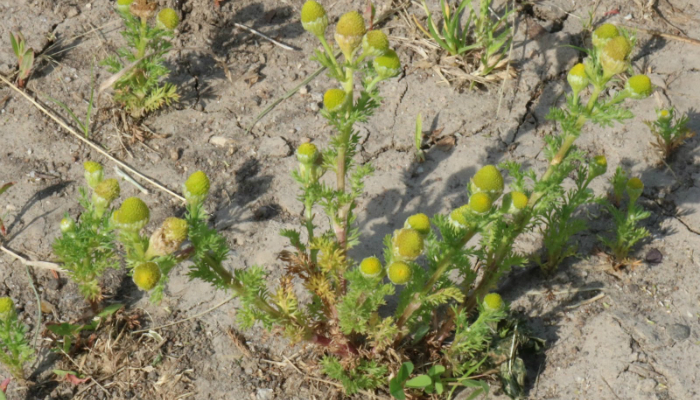The Humble Pineapple Weed

If there is one plant that is evocative of my youth, it is the humble Pineapple Weed (Matricaria discoidea). The gravel driveways of our suburban neighborhood may seem barren and inhospitable, but there were always little green bits that would struggle through and survive the dry baking of the sun, the relentless rolling of car tires and the plucking and trampling of children passing the time during the long summer days.
One of them was an odd little plant, a tiny green cone atop delicate fringed leaves. It didn’t look like a flower–there were no petals, and it was green. It remained nameless for decades until, after coming across it in the hard-packed dirt alongside a trail, I was reminded of those hardy alley residents and went looking for its name in a book of weeds, and discovered it was Pineapple Weed.
The name is due to the sweet smell of its flower head when crushed. And it is a flower, difficult as it was to recognize as such. It is a composite flower, like daisies and coneflowers: what we call a “flower” in this family is actually composed of ray flowers–the colorful petals–and disc flowers, tiny petal-less flowers clustered in the center of the flower (the yellow eye or the daisy, or the spiky cone of the coneflower).
The Pineapple Weed, however, lacks the colorful ray flowers that ring others in the family. Instead it has only the minuscule disc flowers, packed together and formed in a cone. It is closely related to chamomile, and can also be used to make tea, with a variety of medicinal uses attributed to it. It is native to the northwestern US and northeastern Asia, but its scrappy nature allowed it to make its way across the continent and to many other places where humans offer a harsh, degraded plot of land.
I enjoyed the memory of these tough alley-dwellers so much that, years ago, I surreptitiously dug up a plant from a patch of gravel near some railroad tracks and potted it up on my deck using some nice, rich potting soil. It promptly died, and taught me a valuable lesson about how plants are adapted to specific environments, and that not every plant appreciates the pampering we provide to some of our more delicate garden residents.
Originally published on Sycamore Greenway Friends.
Tags: hardy native, Melissa Serenda, pineapple weed

